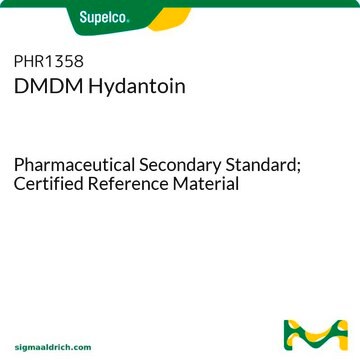D5146
Diazolidinyl urea
≥95%
Synonym(s):
1-[1,3-Bis(hydroxymethyl)-2,5-dioxoimidazolidin-4-yl]-1,3-bis(hydroxymethyl)urea, Diazolidinylurea, N-Hydroxymethyl-N-[1,3-di(hydroxymethyl)-2,5-dioxoimidazolidin-4-yl]-N′-hydroxymethylurea, N-[1,3-Bis(hydroxymethyl)-2,5-dioxo-4-imidazolidinyl]-N,N′-bis(hydroxymethyl)urea
About This Item
Recommended Products
Assay
≥95%
form
powder
storage temp.
2-8°C
SMILES string
OCNC(=O)N(CO)C1N(CO)C(=O)N(CO)C1=O
InChI
1S/C8H14N4O7/c13-1-9-7(18)10(2-14)5-6(17)12(4-16)8(19)11(5)3-15/h5,13-16H,1-4H2,(H,9,18)
InChI key
SOROIESOUPGGFO-UHFFFAOYSA-N
General description
Application
- Impact of cosmetic preservatives on skin cells: A study examined the effects of various cosmetic preservatives, including Diazolidinyl Urea, on healthy human skin cells, highlighting the cellular responses and potential implications for skin health (Głaz et al., 2023).
- Formaldehyde releasers in personal care: An extensive clinical review discussed allergic contact dermatitis caused by formaldehyde and formaldehyde releasers such as Diazolidinyl Urea, providing insights into allergic reactions and safety concerns in dermatological practice (Goossens and Aerts, 2022).
- Carcinogenic potential of cosmetic ingredients: Research on potential carcinogens in makeup cosmetics included Diazolidinyl Urea, emphasizing the safety and regulatory aspects concerning its use in cosmetic formulations (Balwierz et al., 2023).
- Patch testing for allergen sensitivity: A study integrated Diazolidinyl Urea in a patch test series to evaluate skin sensitization and allergic reactions in patients, aiding in the assessment of its allergenic potential (Bizjak et al., 2022).
Disclaimer
Signal Word
Warning
Hazard Statements
Precautionary Statements
Hazard Classifications
Eye Irrit. 2
Storage Class Code
11 - Combustible Solids
WGK
WGK 3
Personal Protective Equipment
Certificates of Analysis (COA)
Search for Certificates of Analysis (COA) by entering the products Lot/Batch Number. Lot and Batch Numbers can be found on a product’s label following the words ‘Lot’ or ‘Batch’.
Already Own This Product?
Find documentation for the products that you have recently purchased in the Document Library.
Customers Also Viewed
Our team of scientists has experience in all areas of research including Life Science, Material Science, Chemical Synthesis, Chromatography, Analytical and many others.
Contact Technical Service
















